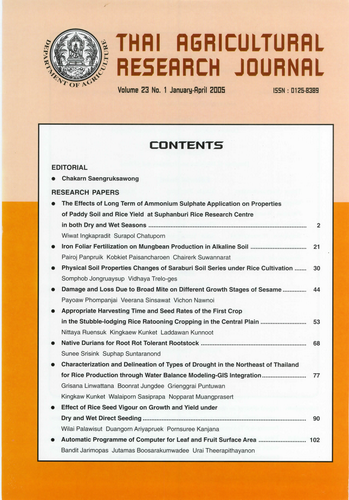Iron Foliar Fertillization on Mungbean Production in Alkaline Soil
DOI:
https://doi.org/10.14456/thaidoa-agres.2005.2Keywords:
mungbean, iron foliar fertilization, alkaline soilAbstract
Two consecutive field experiments were conducted in early and late monsoon seasons in 1999 at Nakhon Sawan farmer’s field (Chai Badan soil soil series; f, smec Leptic Haplusterts) to study the effect of iron foliar fertilization on two mungbean cultivars. The experiments were designed as a split plot whith 4 replications. Two mungbean cultivars namely Kamphaengsaen 2 and Chaninat 72 were used as a main plot ; two sources of iron fertilizer namely FeSO4.7H2O (19%Fe) and Fe-EDDHMA (16%Fe) ; three rate of foliar applications at the rate of 1, 3, 5 kg/rai wrer sub plot. Mungbean were grown at a spacing of 50x20 cm with 3 plants/hill, plot size was 4x6 m and harvested area was 2x4 m. Basal fertilizer were applied at the rates of 3-9-6 kg N-P2O5-K2O/rai and foliar fertilizer were sprayed 5 times at 10, 20, 30, 40 and 50 days after mungbean emergence. Results from the experiment were shown that the yield of Chainat 72 at 150 kg/rai obtained, was higher than Kamphaengsaen 2 which was only 76 kg/rai. Foliar spray of FeSO4.7H2O and Fe-EDDHMA significantly increased of yield Kamphaengsaen 2, the response rate were 3 and 5 kg/rai respectively. However, the iron foliar application didn’t significantly increase the yield Chaninat 72.
Downloads
Published
How to Cite
Issue
Section
License

This work is licensed under a Creative Commons Attribution-NonCommercial-NoDerivatives 4.0 International License.
Thai Agricultural Research Journal



